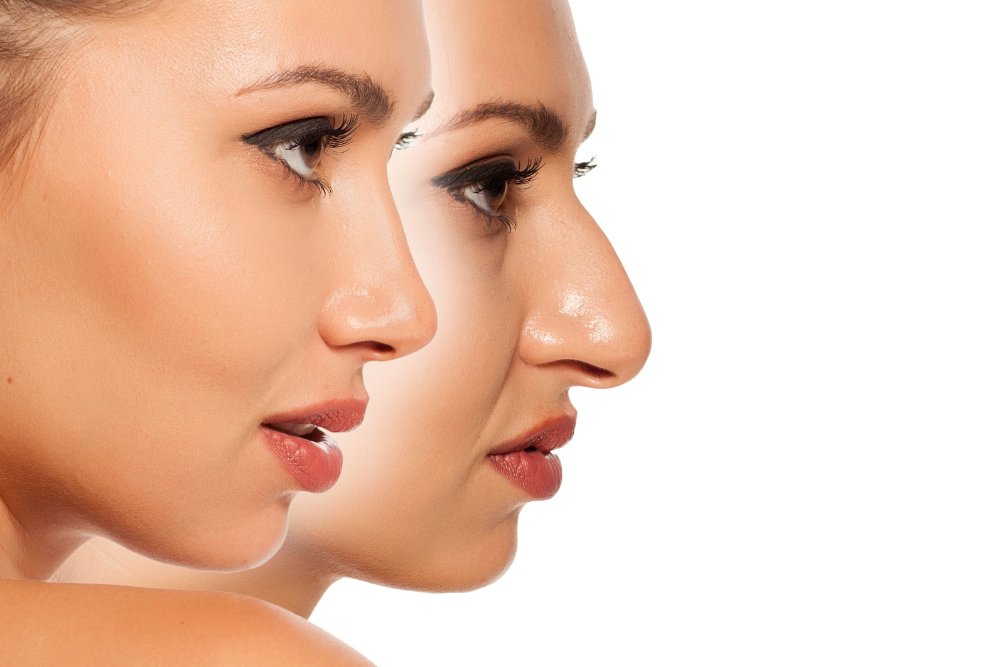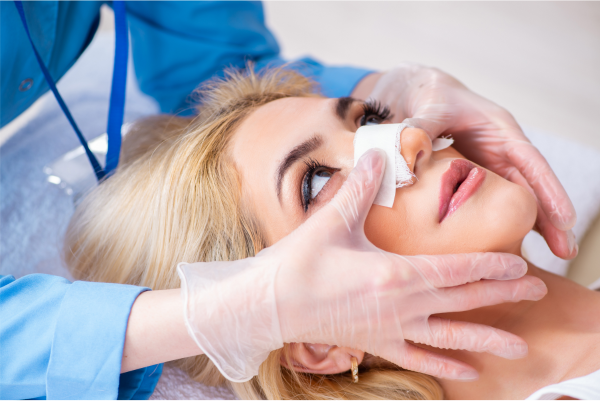Your nose is perhaps your most defining facial feature. Not only does its central location define your facial symmetry, but its shape can affect your breathing and sleeping cycles. And that’s why rhinoplasties are so common.
If you’re considering getting a rhinoplasty in West Hills—either for aesthetic or functional reasons—this guide is for you. It explains the basics of rhinoplasty and what to expect, plus answers to some common questions.
Understanding Rhinoplasty: The Basics
A rhinoplasty is a plastic surgery procedure to reconstruct the nose. Also called a nasal reconstruction surgery or nose job, a rhinoplasty ranks as the most common cosmetic surgical procedure.
According to the American Society of Plastic Surgeons, over 350,000 people receive rhinoplasties each year. Most of these patients are between 20 and 39, but older patients account for nearly 32% of all nasal reconstruction surgeries.
The popularity of nose jobs is nothing new—and the idea of fixing or restructuring the nose has existed for centuries. The first documented rhinoplasty occurred in 1887 and showed how Dr. John Orlando Roe fixed the “pug nose.”
Over the past 130 years, surgeons have perfected the rhinoplasty procedure and designed different surgical procedures to produce incredible results. Whether patients want a different nose shape or relief from breathing problems, a rhinoplasty in West Hills can help.
The Aesthetics of Rhinoplasty
Many patients decide to undergo rhinoplasty to achieve a more attractive nose. Since the nose is a prominent facial feature, its shape and length can affect the entire face. Even a simple change, like adjusting the nostril size, can change a person’s appearance.
The nose is also a central feature, which means its shape affects facial symmetry. A rhinoplasty can fix a crooked nose bridge, misaligned nose, or disproportionate profile view to achieve a more balanced look.
People commonly think rhinoplasties reduce the nose’s size. While that is, of course, possible and a common request, nasal reconstruction can also enhance or lengthen the nose to make it match the facial structure.
Plastic surgeons can also do a rhinoplasty in West Hills to remove a bridge bump, reshape the nasal tip, or create a more feminine (or masculine) nose. Sometimes a rhinoplasty is necessary to fix a botched surgery or to repair the aesthetics of the nose after an accident.
The Functional Aspect of Rhinoplasty
While rhinoplasty commonly addresses aesthetic concerns, it’s just as popular for functional reasons. If a patient is constantly struggling with sleep apnea, congestion, or chronic sinusitis, the underlying problem could be a structural issue with the nose. And a rhinoplasty can fix that.
One common structural issue is a deviated septum, which occurs when the thin wall dividing the nasal airways is off-center. Some people are born with a deviated septum, while others get one from an accident or the natural aging process. Regardless of the cause, a deviated septum can block one or both of the nasal passageways. A plastic surgeon can fix that and open the airways with a rhinoplasty.
Other functional issues that can be fixed with rhinoplasty in West Hills include enlarged turbinates and a collapsed nasal valve. A plastic surgeon can reduce turbinates and structure the nasal valve for improved breathing.
Even things like narrow nostrils and airways can affect a patient’s ability to breathe. However, an experienced plastic surgeon can fix all those issues with a rhinoplasty—and even make the nose more attractive in the process.
Preparing for Rhinoplasty in West Hills
During the initial consultation, a plastic surgeon will examine the patient’s nose and discuss surgical goals, whether they are aesthetic, functional, or both. The specialist will also ask about the patient’s health history, current medications, and comorbidities.
Patients can also expect the surgeon to take pictures of their face and nose and even measure their facial structures. This is the perfect time to discuss surgical options, set realistic expectations, and review the post-op recovery time.
This consultation will likely cover the two main surgical options: open and closed rhinoplasty. An open rhinoplasty is when the surgeon creates a small incision on the outside of the nose and accesses the bone and cartilage from the outside. This process is often recommended when the patient needs an extensive procedure or a repair rhinoplasty.
A closed—or endonasal—rhinoplasty in West Hills involves an internal approach to reconstruction. The plastic surgeon accesses the nasal structure from the inside, never making an incision.
Once the patient and surgeon have decided on a plan of action, they will schedule the operation. In the days leading up to the rhinoplasty, patients should make sure to get plenty of rest and eat healthily. This will help prepare the body for a smooth recovery. Patients should also stop drinking and smoking at least one week before the procedure to ensure the body is in its optimal state.
The Rhinoplasty Procedure: What to Expect
The exact steps in a rhinoplasty depend on what the patient wants and needs. For example, if the patient opts for an open rhinoplasty, the procedure will begin with an incision. Some nose jobs will include only restructuring by reducing bone and cartilage, while others will also include nasal septum repair.
Regardless of what the patient wants, all rhinoplasties start with a pre-op examination and anesthesia. Some surgeons may offer intravenous or general anesthesia, depending on the situation. The entire procedure may take anywhere between 1.5 and 3 hours—sometimes longer.
Recovery and Post-Operative Care
Immediately after the surgery, patients can expect to feel a bit groggy as the effects of general anesthesia wear off. They should make sure someone can drive them home and even stay with them overnight to ensure they are comfortable.
For the first week, patients will wear a small cast on the nose and experience mild side effects. Facial bruising and mild pain are quite common, but the surgeon typically provides a prescription to help patients manage any headaches. Patients can also expect to feel congested during those first few days, and they might even see minor nose bleeds during the first two days.
To help ensure quick recovery, patients can regularly apply ice packs to the eye and cheek area during the first three days. They should also avoid getting the split wet when bathing. Even when the surgeon removes the cast after the first week, patients should avoid rapid movements, blowing their nose, and any situations where they could injure their nose for at least 2-3 weeks.
Within a few weeks, the bruising will go now, and patients will feel little to no symptoms. However, internal healing can take much longer—sometimes months—so patients should avoid any contact sports for at least three months.
Evaluating Results: When Can You See the Final Outcome?
Even though most side effects dissipate in a few weeks, it usually takes months for patients to see the final result. There’s usually still swelling in the nose six months after rhinoplasty in West Hills, sometimes even longer, and the skin often takes up to a year to fully settle around the new nasal structure. Patients that receive extensive surgery—especially in the nasal tip—might not see complete results for three years.
Patients should talk to their surgeon before the surgery about what to expect. Some procedures will produce a more dramatic result, while others are more subtle. Likewise, certain procedures will take longer to heal internally.
FAQs About Rhinoplasty in West Hills
What’s the most difficult part of a rhinoplasty?
Generally speaking, the most difficult part of rhinoplasty is the first few days after the procedure. The patient may feel uncomfortable with the excess congestion, swelling, and lingering effects of anesthesia. However, these side effects quickly pass.
Is rhinoplasty painful?
Rhinoplasty is a complex cosmetic procedure, but it all occurs while the patient is under anesthesia, so they don’t feel it. After the operation, the patient may experience mild pain. However, they usually have prescription medication to help with the pain.
Are rhinoplasty results immediate?
No, rhinoplasty results are not immediate. Patients should expect to wait six months to a year (or longer) to see the final results. It takes time for the swelling to reduce and the skin to settle into the new structure. An experienced plastic surgeon can help set realistic expectations for a rhinoplasty.
What percentage of rhinoplasties fail?
The revision rhinoplasty rate is extremely low. An NIH study reported that less than 3% of open rhinoplasty patients got repeat nose jobs. That percentage dropped to 1.5% for closed rhinoplasty patients. In other words, most rhinoplasties are successful.
Conclusion
Whether you want a different nose shape or the ability to breathe better, a rhinoplasty in West Hills can help. An experienced plastic surgeon can create a plan to address all your considers and help you set realistic expectations.


